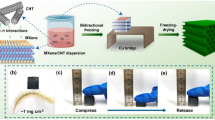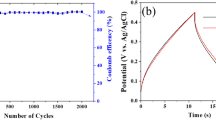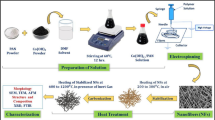Abstract
Heteroatoms in situ-doped hierarchical porous hollow-activated carbons (HPHACs) have been prepared innovatively by pyrolyzation of setaria viridis combined with alkaline activation for the first time. The micro-morphology, pore structure, chemical compositions, and electrochemical properties are researched in detail. The obtained HPHACs are served as outstanding electrode materials in electrochemical energy storage ascribe to the particular hierarchical porous and hollow structure, and the precursor setaria viridis is advantage of eco-friendly as well as cost-effective. Electrochemical measurement results of the HPHACs electrodes exhibit not only high specific capacitance of 350 F g−1 at 0.2 A g−1, and impressive surface specific capacitance (Cs) of 49.9 μF cm−2, but also substantial rate capability of 68% retention (238 F g−1 at 10 A g−1) and good cycle stability with 99% retention over 5000 cycles at 5 A g−1 in 6 M KOH. Besides, the symmetrical supercapacitor device based on the HPHACs electrodes exhibits excellent energy density of 49.5 Wh kg−1 at power density of 175 W kg−1, but still maintains favorable energy density of 32.0 Wh kg−1 at current density of 1 A g−1 in 1-ethy-3-methylimidazolium tetrafluoroborate (EMIMBF4) ionic liquid electrolyte, and the excellent cycle stability behaviour shows the nearly 97% ratio capacitance retention of the initial capacitance after 10,000 cycles at current density of 2 A g−1. Overall, the results indicate that HPHACs derived from setaria viridis have appealing electrochemical performances thus are promising electrode materials for supercapacitor devices and large-scale applications.









Similar content being viewed by others
References
Dutta S, Bhaumik A, Wu KCW (2014) Hierarchically porous carbon derived from polymers and biomass: effect of interconnected pores on energy applications. Energy Environ Sci 7:3574
Wang G, Zhang L, Zhang J (2012) A review of electrode materials for electrochemical supercapacitors. Chem Soc Rev 41:797
Zhang Q, Uchaker E, Candelaria SL, Cao G (2013) Nanomaterials for energy conversion and storage. Chem Soc Rev 42:3127
Yan J, Wang Q, Wei T, Fan Z (2014) Recent advances in design and fabrication of electrochemical supercapacitors with high energy densities. Adv Energy Mater 4:1
Yu G, Xie X, Pan L, Bao Z, Cui Y (2013) Hybrid nanostructured materials for high-performance electrochemical capacitors. Nano Energy 2:213
Zhang J, Terrones M, Park CR, Mukherjee R, Monthioux M, Koratkar N, Kim YS, Hurt R, Frackowiak E, Enoki T, Chen Y, Chen Y, Bianco A (2016) Carbon science in 2016: status, challenges and perspectives. Carbon 98:708
Zhai Y, Dou Y, Zhao D, Fulvio PF, Mayes RT, Dai S (2011) Carbon materials for chemical capacitive energy storage. Adv Mater 23:4828
Qu D, Shi H (1998) Studies of activated carbons used in double-layer capacitors. J Power Sources 74:99
Jiang H, Lee PS, Li C (2013) 3D carbon based nanostructures for advanced supercapacitors. Energy Environ Sci 6:41
Jain A, Balasubramanian R, Srinivasan MP (2016) Hydrothermal conversion of biomass waste to activated carbon with high porosity: a review. Chem Eng J 283:789
Wang C, Wu D, Wang H, Gao Z, Xu F, Jiang K (2018) Biomass derived nitrogen-doped hierarchical porous carbon sheets for supercapacitors with high performance. J Colloid Interf Sci 523:133
Peng C, Yan X, Wang R, Lang J, Ou Y, Xue Q (2013) Promising activated carbons derived from waste tea-leaves and their application in high performance supercapacitors electrodes. Electrochim Acta 87:401
Li X, Xing W, Zhuo S, Zhou J, Li F, Qiao SZ, Lu GQ (2011) Preparation of capacitor’s electrode from sunflower seed shell. Bioresour Technol 102:1118
Mi J, Wang XR, Fan R, Qu WH, Li WC (2012) Coconut-shell-based porous carbons with a tunable micro/mesopore ratio for high-performance supercapacitors. Energy Fuels 26:5321
Sun L, Tian C, Li M, Meng X, Wang L, Wang R, Yin J, Fu H (2013) From coconut shell to porous graphene-like nanosheets for high-power supercapacitors. J Mater Chem A 1:6462
Choi WS, Shim WG, Ryu DW, Hwang MJ, Moon H (2012) Effect of ball milling on electrochemical characteristics of walnut shell-based carbon electrodes for EDLCs. Microporous Mesoporous Mater 155:274
Elmouwahidi A, Zapata-Benabithe Z, Carrasco-Marín F, Moreno-Castilla C (2012) Activated carbons from KOH-activation of argan (Argania spinosa) seed shells as supercapacitor electrodes. Bioresour Technol 111:185
Wang K, Yan R, Zhao N, Tian X, Li X, Lei S, Song Y, Guo Q, Liu L (2016) Bio-inspired hollow activated carbon microtubes derived from willow catkins for supercapacitors with high volumetric performance. Mater Lett 174:249
Wang K, Song Y, Yan R, Zhao N, Tian X, Li X, Guo Q, Liu Z (2017) High capacitive performance of hollow activated carbon fibers derived from willow catkins. Appl Surf Sci 394:569
Wang K, Zhao N, Lei S, Yan R, Tian X, Wang J, Song Y, Xu D, Guo Q, Liu L (2015) Promising biomass-based activated carbons derived from willow catkins for high performance supercapacitors. Electrochim Acta 166:1
Rufford TE, Hulicova-Jurcakova D, Khosla K, Zhu Z, Lu GQ (2010) Microstructure and electrochemical double-layer capacitance of carbon electrodes prepared by zinc chloride activation of sugar cane bagasse. J Power Sources 195:912
Chen W, Zhang H, Huang Y, Wang W (2010) A fish scale based hierarchical lamellar porous carbon material obtained using a natural template for high performance electrochemical capacitors. J Mater Chem 20:4773
Huang W, Zhang H, Huang Y, Wang W, Wei S (2011) Hierarchical porous carbon obtained from animal bone and evaluation in electric double-layer capacitors. Carbon 49:838
Zhi L, Li Z, Shalchi AB, Xuehai T, Zhanwei X, Huanlei W, David M (2012) Carbonized chicken eggshell membranes with 3D architectures as high-performance electrode materials for supercapacitors. Adv Energy Mater 2:431
Raymundo-Piñero E, Leroux F, Béguin F (2006) A high-performance carbon for supercapacitors obtained by carbonization of a seaweed biopolymer. Adv Mater 18:1877
Liu C, Yu Z, Neff D, Zhamu A, Jang BZ (2010) Graphene-based supercapacitor with an ultrahigh energy density. Nano Lett 10:4863
Li B, Dai F, Xiao Q, Yang L, Shen J, Zhang C, Cai M (2016) Nitrogen-doped activated carbon for a high energy hybrid supercapacitor. Energy Environ Sci 9:102
Tian X, Li X, Yang T, Wang K, Wang H, Song Y, Liu Z, Guo Q, Chen C (2017) Flexible carbon nanofiber mats with improved graphitic structure as scaffolds for efficient all-solid-state supercapacitor. Electrochim Acta 247:1060
Tian X, Li X, Yang T, Wang K, Wang H, Song Y, Liu Z, Guo Q (2018) Porous worm-like NiMoO4 coaxially decorated electrospun carbon nanofiber as binder-free electrodes for high performance supercapacitors and lithium-ion batteries. Appl Surf Sci 434:49
Wang R, Wang P, Yan X, Lang J, Peng C, Xue Q (2012) Promising porous carbon derived from celtuce leaves with outstanding supercapacitance and CO2 capture performance. ACS Appl Mater Interf 4:5800
Biswal M, Banerjee A, Deo M, Ogale S (2013) From dead leaves to high energy density supercapacitors. Energy Environ Sci 6:1249
Hou J, Cao C, Idrees F, Ma X (2015) Hierarchical porous nitrogen-doped carbon nanosheets derived from silk for ultrahigh-capacity battery anodes and supercapacitors. ACS Nano 9:2556
Orfão JJM, Antunes FJA, Figueiredo JL (1999) Pyrolysis kinetics of lignocellulosic materials-three independent reactions model. Fuel 78:349
Tsamba AJ, Yang W, Blasiak W (2006) Pyrolysis characteristics and global kinetics of coconut and cashew nut shells. Fuel Process Technol 87:523
Liu Y, Chae HG, Choi YH, Kumar S (2015) Preparation of low density hollow carbon fibers by bi-component gel-spinning method. J Mater Sci 50:3614
Guan T, Li K, Zhao J, Zhao R, Zhang G, Zhang D, Wang J (2017) Template-free preparation of layer-stacked hierarchical porous carbons from coal tar pitch for high performance all-solid-state supercapacitors. J Mater Chem A 5:15869
Guo Y, Shi Z, Chen M, Wang C (2014) Hierarchical porous carbon derived from sulfonated pitch for electrical double layer capacitors. J Power Sources 252:235
Zheng Z, Gao Q (2011) Hierarchical porous carbons prepared by an easy one-step carbonization and activation of phenol–formaldehyde resins with high performance for supercapacitors. J Power Sources 196:1615
Wang J, Kaskel S (2012) KOH activation of carbon-based materials for energy storage. J Mater Chem 22:23710
Lillo-Ródenas MA, Cazorla-Amorós D, Linares-Solano A (2003) Understanding chemical reactions between carbons and NaOH and KOH: an insight into the chemical activation mechanism. Carbon 41:267
Zolyomi VKJ, Kurti J (2011) Resonance raman spectroscopy of graphite and graphene. Phys Status Solidi-b 248:2435
Qian W, Sun F, Xu Y, Qiu L, Liu C, Wang S, Yan F (2014) Human hair-derived carbon flakes for electrochemical supercapacitors. Energy Environ Sci 7:379
Wang C, Zhao Z, Li X, Yan R, Wang J, Li A, Duan X, Wang J, Liu Y, Wang J (2017) Three-dimensional framework of graphene nanomeshes shell/Co3O4 synthesized as superior bifunctional electrocatalyst for Zinc-Air batteries. ACS Appl Mater Interf 9:41273
Chen J, Xu J, Zhou S, Zhao N, Wong CP (2016) Nitrogen-doped hierarchically porous carbon foam: a free-standing electrode and mechanical support for high-performance supercapacitors. Nano Energy 25:193
Chen Y, Liu Z, Sun L, Lu Z, Zhuo K (2018) Nitrogen and sulfur co-doped porous graphene aerogel as an efficient electrode material for high performance supercapacitor in ionic liquid electrolyte. J Power Sour 390:215
Tian X, Zhao N, Song Y, Wang K, Xu D, Li X, Guo Q, Liu L (2015) Synthesis of nitrogen-doped electrospun carbon nanofibers with superior performance as efficient supercapacitor electrodes in alkaline solution. Electrochim Acta 185:40
Hulicova-Jurcakova D, Seredych M, Lu GQ, Bandosz TJ (2009) Combined effect of nitrogen- and oxygen-containing functional groups of microporous activated carbon on its electrochemical performance in supercapacitors. Adv Funct Mater 19:438
Zhao L, Fan LZ, Zhou MQ, Guan H, Qiao S, Markus A, Maria-Magdalena T (2010) Nitrogen-containing hydrothermal carbons with superior performance in supercapacitors. Adv Mater 22:5202
Song S, Ma F, Wu G, Ma D, Geng W, Wan J (2015) Facile self-templating large scale preparation of biomass-derived 3D hierarchical porous carbon for advanced supercapacitors. J Mater Chem A 3:18154
White RJ, Budarin V, Luque R, Clark JH, Macquarrie DJ (2009) Tuneable porous carbonaceous materials from renewable resources. Chem Soc Rev 38:3401
Zhai D, Li B, Kang F, Du H, Xu C (2010) Preparation of mesophase-pitch-based activated carbons for electric double layer capacitors with high energy density. Microporous Mesoporous Mater 130:224
Sun G, Li K, Xie L, Wang J, Li Y (2012) Preparation of mesoporous carbon spheres with a bimodal pore size distribution and its application for electrochemical double layer capacitors based on ionic liquid as the electrolyte. Microporous Mesoporous Mater 151:282
Zhou J, Xing W, Zhuo S, Zhao Y (2011) Capacitive performance of ordered mesoporous carbons with tunable porous texture in ionic liquid electrolytes. Solid State Sci 13:2000
Zhou D, Wang H, Mao N, Chen Y, Zhou Y, Yin T, Xie H, Liu W, Chen S, Wang X (2017) High energy supercapacitors based on interconnected porous carbon nanosheets with ionic liquid electrolyte. Microporous Mesoporous Mater 241:202
Tee E, Tallo I, Thomberg T, Jänes A, Lust E (2016) Supercapacitors based on activated silicon carbide-derived carbon materials and ionic liquid. J Electrochem Soc 163:A1317
Pandey GP, Liu T, Hancock C, Li Y, Sun XS, Li J (2016) Thermostable gel polymer electrolyte based on succinonitrile and ionic liquid for high-performance solid-state supercapacitors. J Power Sources 328:510
Shen B, Zhang X, Guo R, Lang J, Chen J, Yan X (2016) Carbon encapsulated RuO2 nano-dots anchoring on graphene as an electrode for asymmetric supercapacitors with ultralong cycle life in an ionic liquid electrolyte. J Mater Chem A 4:8180
Zhang X, Wang L, Peng J, Cao P, Cai X, Li J, Zhai M (2015) A flexible ionic liquid gelled PVA-Li2SO4 polymer electrolyte for semi-solid-state supercapacitors. Adv Mater Interf 2:1500267
Shaikh JS, Shaikh NS, Kharade R, Beknalkar SA, Patil JV, Suryawanshi MP, Kanjanaboos P, Hong CK, Kim JH, Patil PS (2018) Symmetric supercapacitor: sulphurized graphene and ionic liquid. J Colloid Interf Sci 527:40
He X, Ling P, Qiu J, Yu M, Zhang X, Yu C, Zheng M (2013) Efficient preparation of biomass-based mesoporous carbons for supercapacitors with both high energy density and high power density. J Power Sources 240:109
Zou Z, Liu T, Jiang C (2018) Highly mesoporous carbon flakes derived from a tubular biomass for high power electrochemical energy storage in organic electrolyte. Mater Chem Phys. https://doi.org/10.1016/j.matchemphys.2018.10.036
Sun J, Niu J, Liu M, Ji J, Dou M, Wang F (2018) Biomass-derived nitrogen-doped porous carbons with tailared hierarchical porosity and high specific surface area for high energy and power density supercapacitors. Appl Surf Sci 427:807
Yun YS, Park MH, Hong SJ, Lee ME, Park YW, Jin HJ (2015) Hierarchically porous carbon nanosheets from waste coffee grounds for supercapacitors. ACS Appl Mater Interfaces 7:3684
Acknowledgements
This work was financially sponsored by the Fund for Shanxi “1331 Project” Key Subjects Construction (1331KSC), Program for the (Reserved) Discipline Leaders of Taiyuan Institute of Technology (2017), the Scientific Research Start-up Funds provided by Taiyuan Institute of Technology and the National Natural Science Foundation Item (21576277).
Author information
Authors and Affiliations
Corresponding authors
Additional information
Publisher's Note
Springer Nature remains neutral with regard to jurisdictional claims in published maps and institutional affiliations.
Electronic supplementary material
Below is the link to the electronic supplementary material.
Rights and permissions
About this article
Cite this article
Yan, R., Wang, K., Tian, X. et al. Heteroatoms in situ-doped hierarchical porous hollow-activated carbons for high-performance supercapacitor. Carbon Lett. 30, 331–344 (2020). https://doi.org/10.1007/s42823-019-00102-3
Received:
Revised:
Accepted:
Published:
Issue Date:
DOI: https://doi.org/10.1007/s42823-019-00102-3




